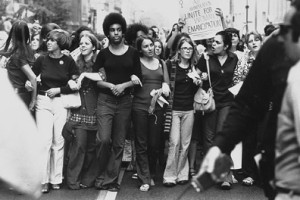The women’s movement of the 1970s has taken quite a beating by people who draw their history from media & others who want to vilify feminism. Feminism erupted in the late 1960s from every niche of society; women from the Civil Rights Movement, from religious groups, students, working women, Black & Latino women, lesbians. Betty Friedan is attributed with starting the movement with her book “The Feminine Mystique” but many activists had never read her boring book which dealt with white middle class, well-educated women. Feminism was a much broader & deeper social rebellion than her book envisioned.
The movement is misrepresented as white & middle-class, racist, lesbians & spinsters, blue-nosed. That’s not history; that’s how media always portrayed the movement to deter women from identifying with feminism–which is a volatile force for social transformation. Media depiction of feminism is a punk caricature & regrettably the slanders have not been sufficiently countered by feminists of that era.
Feminism & the Vietnam War were my first political awakenings & both began to matter to me when I was a novice in a convent in the early 1960s. My brother was a soldier in the war & I was not allowed to read about it. Here I was a student of history & not allowed to be part of my own times. What rankled me most was the unequal treatment of men & women in the Catholic Church. While we were kept encaged & infantalized, the priests were out gallivanting without the constant supervision we were subjected to. So I made my break & within a year was involved in the antiwar movement. There was no women’s movement yet so I read Catholic writers who identified with the new ideas of feminism; I’d actually never heard of Betty Friedan. When the women’s movement began to emerge, I headed for New York City to be part of it.
I arrived in time to build the first women’s liberation march of August 26, 1970. The demands of that march were: Equal pay; childcare; abortion rights & no forced sterilization. No forced sterilization was essential to distinguish feminism from the eugenics groups who wanted abortion rights for license to control the population of black & brown women. It was a major issue for Black, Latino, & Native American women who were routinely sterilized without their knowledge or consent. At the time, it was reported 30% of the women of Puerto Rico were force sterilized. It remains a problem in population control programs.
It was my personal & political history & I am writing a series of essays to correct the historical record about this magnificent movement which was only on the stage of history briefly before it was derailed into the Democratic Party.
I certainly wasn’t the star of the show but I played a small part by organizing the publicity for the march. One of our jobs was to go out every night with march posters & plastering brushes hidden in pizza boxes to wallpaper the city. We got hauled in by the cops a couple times; we got arrested postering the Playboy Club in Manhattan.
I accidentally came across this audio thingamajig on the internet of me giving a report on the plastering & answering an interviewer. You can see I was still fumbling my way through an understanding of women’s oppression. I’m not a boastful soul but am very proud of my participation in the women’s movement & met some wonderful women. I continued activism primarily around abortion rights on the campus of NYU where I worked as a secretary.
Photo is August 26 1970 Women’s March for Equality down Fifth Avenue in NYC on the 50th anniversary of the 19th Amendment in the US Bill of Rights which gave women the right to vote.
(Photo by John Olsen)
http://www.wnyc.org/story/87675-celebrating-international-womens-day-a-look-at-how-we-got-here/
